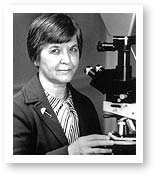Prominent Poles
Stephanie Louise Kwolek, Polish-American chemist, inventor of Kevlar, inducted into the National Inventors Hall of Fame

Born: Born: July 31, 1923, New Kensington, Pennsylvania, USA
Early days. Her father , John Kwolek , a foundry worker who died when she was 10 years old, was a naturalist by avocation. She spent many hours with him exploring the woods and fields near her home and filling scrapbooks with leaves, wildflowers, seeds, grasses, and pertinent descriptions. From her mother, Nellie Zajdel Kwolek, first a homemaker and then by necessity a career woman working for Aluminum Company of America, Kwolek inherited a love of fabrics and sewing. At one time she thought she might become a fashion designer, but her mother warned her that she would probably starve in that business because she was such a perfectionist. Later Kwolek became interested in teaching and then in chemistry and medicine. She enrolled in the Carnegie Institute of Technology (the women's college of what is now Carnegie Mellon University) in Pittsburgh in 1942, graduating with a bachelor's degree in chemistry in 1946.
Professional career. She received her B.S. in chemistry from the Carnegie Institute of Technology (now Carnegie Mellon University) in 1946, originally hoping to continue to medical school. However, she lacked the money and instead took a job as a research chemist with DuPont's textile fibers department in Buffalo, NY, specializing in low-temperature processes for the preparation of condensation polymers. At DuPont the polymer research she worked on was so interesting and challenging that she decided to drop her plans for medical school and make chemistry a lifetime career. She soon earned a transfer to DuPont's Pioneering Research Laboratory in Wilmington, Delaware, when it opened in 1950. Here, with the support of W. Hale Charch, the first Director of the Lab, Kwolek had a string of successes in the search for new and better polymers. In 1965, she discovered an entirely new branch of synthetics, liquid crystalline polymers, and prepared the first pure monomers used to synthesize polybenzamide.
But Kwolek was also interested in the intermediates necessary for this process of synthesis, which, being ultra-sensitive to moisture and heat, too easily underwent hydrolysis and self-polymerization. So she discovered an acceptable solvent and created appropriate low-temperature polymerization conditions for these intermediates. The result was an aramid polymer that most researchers would have rejected, since it was fluid and cloudy, rather than viscous and clear. Kwolek, acting on instinct, insisted on spinning out the solution, and the result was astonishing: synthetic fibers much stiffer and stronger than any created before. Consequently she discovering the first of a family of synthetic fibers of exceptional strength and stiffness. The best known member is poly-paraphenylene terephtalamide, better known as Kevlar, a fiber five times stronger ounce for ounce than steel, but about half the density of fiberglass. It is used in fragmentation-resistant vests (and in this use alone Kwolek's discovery has saved thousands of lives) as well as racing sails, fiberoptic cable, water-, air- and spacecraft shells, airplanes, ropes, cables, radial tires, tennis racquets, skis, safety helmets, and hiking and camping gear and so forth—in total about 200 applications. She is recipient or co-recipient of 17 US patents, including one for the spinning method that made commercial aramid fibers feasible, and 5 for the prototype from which Kevlar® was created. Kwolek continues to consult part-time for DuPont.
Honors and awards.,
1995 Inducted into the National Inventors Hall of Fame as only the fourth woman member of 113.
1996 National Medal of Technology
Kilby Award 1997 the Perkin Medal, presented by the American Section of the Society of Chemical Industry for her outstanding achievements in applied chemistry, only the second woman to receive this honor
1999 Lemelson-MIT Lifetime Achievement Award
Howard N. Potts Medal from the Franklin Institute of Philadelphia for the discovery of liquid crystalline solutions of synthetic polyamides and resulting fibers
DuPont Honoree at the Bicentennial Celebration of the United States Patent and Copyright Laws
SAMPE George Lubin Memorial Award for meritorious achievement in the advancement of material and process engineering
inducted into the Dayton, Ohio, Engineering and Science Hall of Fame
inducted intoUniversity of Akron's Polymer Processing Hall of Fame
The American Innovator Award from the Patent & Trademark Office
Chemical Pioneer Award from the American Institute of Chemists
She has served as a mentor for other women scientists and participated in programs that introduce young children to science. One of Kwolek's most cited papers, written with Paul W. Morgan, is "The Nylon Rope Trick" (Journal of Chemical Education, April 1959, 36:182–184). It describes how to demonstrate condensation polymerization in a beaker at atmospheric pressure and room temperature—a demonstration now common in classrooms across the nation
This article uses, among others, material from the Wikipedia article "Stephanie Kwolek" licensed under the GNU Free Documentation License. :
Wikipedia
Answers (Wikipedia)
Other sources include:
Inventor
Chemical Achievers
MIT
Encyclopedia Britannica Premium Service
Current Issues
Return to home page:
Prominent Poles
